

HOTSPOT -
You are working with a customer to plan a go-live deployment to their production environment. The solution includes several apps and environment variables. The superuser team manages the production environment that is secured by using a specific environment Azure AD security group.
The following issues have been identified:
✑ The superuser team cannot access make.powerapps.com to open and set the environment variables.
Users are added to the environment Azure AD security group and are not able to access the model-driven app.
✑ Users are added to the environment Azure AD security group and are not able to access the canvas app.
You need to resolve the issues.
What should you do? To answer, select the appropriate options in the answer area.
NOTE: Each correct selection is worth one point.
Hot Area:

avow
Highly Voted 2 years, 9 months agopetertwilliams
Highly Voted 2 years, 8 months agoHamed64
Most Recent 1 week, 1 day agoloftuscheek
3 months agojgg
10 months agoMrEz
1 year, 3 months agoSslavko
1 year, 9 months agoAcrious
1 year, 11 months agoCloudz_1
2 years agoCoder1
2 years, 1 month agodlnuser
2 years, 1 month agoSkada
2 years, 2 months agoArezouDynamics
2 years, 8 months agoaok95
2 years, 3 months agomister_exam
2 years, 9 months agoAlRe
2 years, 9 months agoTheBinMan
2 years, 9 months agoavow
2 years, 9 months agorogrod
2 years, 8 months ago